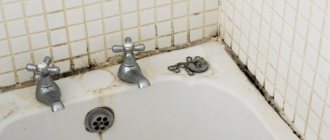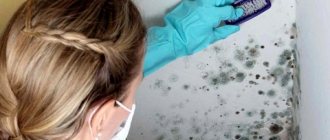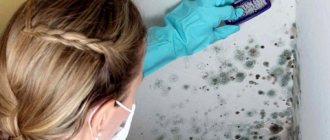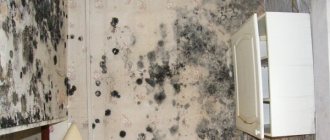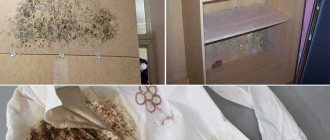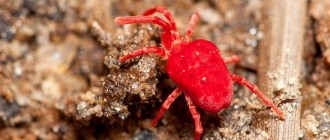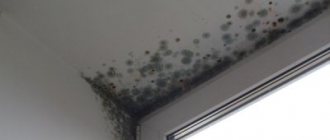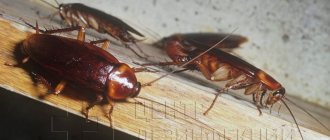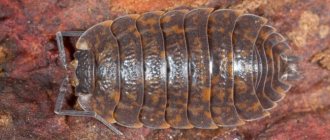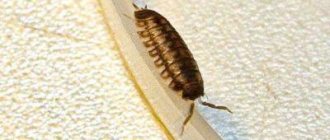- April 1, 2019
- Walls
- Ksenia Yedikhanova
Most people have at least once encountered the problem of black mold on the walls of their home. It consists of small black specks that no one pays attention to and simply erases them. Unfortunately, it soon begins to grow and become larger in size. How to get rid of black mold on the walls of an apartment? Effective methods and nuances are described in the article.
Habitat
Where is black mold most likely to appear? She, like all fungi, needs a nutrient medium. The most suitable conditions for its life are damp places. For example, if there is a problem with leaking pipes in the bathroom, then there is a high probability of dark spots forming on the walls.
In addition, black mold can be found anywhere - in the refrigerator, near ventilation grilles, vents, on bread, fabric, under the sink, bathtub, at the joints of tiles, in places where the shower stall or bathtub touches the walls.
The main condition for the existence of black mold is high humidity. It can feed on both organic and inorganic products, such as glue and wallpaper.
Tumor in the heart of foggy albion
In 2016, one resident of Britain, practically from its geographical center - Nottingham, published a story of the torment that befell her in the last years of her life. The article was published under the title “When I was dying.” I will retell it briefly and as accurately as possible:
“For many years I suffered from bouts of illness and a variety of continuous flu-like symptoms. I couldn’t stop coughing, I sweated at night, and felt physically exhausted. I was constantly treated with antibiotics and antihistamines. I had previously been diagnosed with asthma and would cough up brown plugs of mucus every morning.
The last attack of the disease occurred in March 2015, its intensity was very similar to the previous one, with constant pain in the right lung. A course of antibiotics did not give anything, they prescribed salbutamol and sent me for an x-ray. X-ray showed a mass in the right lung. They sent me for a CT scan. The cough got worse. The attacks turned into vomiting. It was impossible to breathe even with salbutamol. Based on the results of the CT scan, the doctors diagnosed “a greatly expanded malignant tumor, partial obstruction of the lung.” They sent me for a bronchoscopy, but it couldn’t be done due to breathing problems.”
X-ray of a small fungal tumor:
The woman begins to prepare for her funeral and look for a place for the operation, calling paid cancer centers. She is visited by family, friends and relatives. She's supported, which is great. She is getting worse every day. Although nothing other than CT and X-rays indicates cancer. She is transferred to different institutions until the medical commission, together with the diagnostician, suspects the diagnosis based only on the images. After consulting in medical circles, they begin to suspect that it may not be cancer. New tests are ordered. These include analysis of immunoglobulin E for aspergillosis. The result obtained was so high that it was outside the rating scale. The woman was diagnosed with advanced and expanded allergic bronchopulmonary aspergillosis. The picture was so terrible that both the CT scan and the x-ray exactly matched the characteristics and appearance of a malignant tumor that occupied almost the entire lung.
X-ray of a large fungal tumor:
Betsy was eventually saved, and she successfully transitioned from acute to chronic, leaving this world with a cough, the need for constant treatment and a terrible life experience. In her case, doctors concluded that the culprit was a compost heap in Betsy's backyard garden. But is it really that simple?
“Aspergillosis” is just a general name for a very immodest group of diseases caused by fungi of the genus Aspergillus. For the most part, the disease is most typical for already sick or severely weakened people. These are everyone who has suffered or is still suffering from a wide variety of lung-related diseases: from tuberculosis and chronic obstructive pulmonary disease to asthma and severe allergies. In Betsy’s case, she acquired aspergilloma; in other words, fungal mycelium grew in her lungs. In order for fungi to grow in the bronchus or lung, it is not enough to simply inhale mold spores. You do this all the time anyway. In order for them to take root, it is necessary to have damage (in the form of a granuloma, for example). And then, once in the cavity of the granuloma, abscess or cyst, the spores germinate and aspergilloma begins to grow.
The process can be very long; the tissues of the bronchi and lungs will gradually deteriorate, becoming involved in the formation of detritus - dead cells at the base of the fungus. The patient can simply cough for a long time, until his condition gradually deteriorates, the attacks become stronger, mucus and sputum appear, it becomes greenish, flakes, blood, pieces of bronchi and fungus are added. Aspergilloma itself can grow almost anywhere, but the lungs come first due to the largest number of spores getting there, the second ear canal. But if the spores enter an organism deprived of protection, they can be carried away to the liver and kidneys. Where, with low or impaired immunity, something will definitely grow. Jacques was unlucky with his maxillary sinus.
Macro photograph of a small aspergilloma in tissue:
In the past, it was relatively difficult to grow mushrooms in yourself. Laboratory observations in large cities such as San Francisco revealed 1-2 cases per 100,000 population (data for 1992-1993). But since the advent of immunosuppressants, which began to treat various types of allergies, and the increase in organ implantation, more than 15,000 cases per year of invasive forms of aspergillosis began to be recorded in the United States alone. If this is not enough for you, add another 6 million people with the allergic bronchopulmonary form. This is when the immune system, on the contrary, reacts too actively to spores. A cough appears, injuries, scars...
Causes
How to get rid of black mold in an apartment? To do this, you need to eliminate the main causes of its occurrence. As stated earlier, the optimal habitat for mold is high humidity in the home, which, in turn, is provoked by the following reasons:
- poor ventilation;
- dampness in the basement;
- walls that freeze in winter;
- a large number of plants that require frequent spraying;
- constant drying of large amounts of laundry in the living room;
- poor insulation of inter-wall seams and cracks;
- insufficient heating of the home.
Mold can also appear if there are cracks in the house through which moisture enters from the outside and destroys the wall from the inside. If mold gets inside such a crack, getting rid of it can be problematic.
Types of mold
In order to know how to remove black mold, you need to decide on its type. The general name usually refers to several of the most common types of molds:
- Aspergillus black is a fungus that loves high humidity. This is what appears in the bathroom, kitchen or even in the air conditioner. Most often it attacks the seams between tiles in the bathroom or toilet.
- Aspergillus fuming, the peculiarity of which is that it can easily withstand temperatures up to 53 degrees, and is therefore resistant to high temperatures in the bathroom.
- Alternaria alternata is a black fungus that attacks fabric and food, as well as wood.
These mold spores are equally dangerous to both humans and pets, so if they appear, you should get rid of them as soon as possible.
The harmful effects of mold on the human body
All organisms on the planet have their purpose and, despite the importance of the presence of black mold in the ecosystem, its presence in human life leads to harmful effects on the body; toxins released by microorganisms poison the respiratory tract and organs. Black mold feeds on dead organic matter and reproduces rapidly through spores. The rate of its growth cannot be controlled.
The health effects from airborne and direct contact are equally dangerous. If you don’t put all your efforts into destroying it, the consequences of fungal damage to walls for residents can be:
- allergy;
- asthma;
- dermatitis;
- rhinitis;
- bronchitis.
- conjunctivitis.
Black fungi can cause tuberculosis, suffocation and many other problems. To protect yourself from their effects, you must initially not neglect prevention, not giving microorganisms a single chance to settle in the house.
What is the danger?
At first glance, mold may seem unpleasant but harmless, but this is not the case. Black mold can cause serious harm to humans, including death. If you live near mold fungi for a long time, the following health problems may appear:
- Dermatitis and other skin diseases, the nature of which is difficult to determine, which means they are difficult to treat.
- Diseases of the respiratory system, such as asthma, bronchitis, pneumonia.
- Diseases of the musculoskeletal system, as mold spores negatively affect human joints.
- Allergic reactions up to Quincke's edema.
- Once inside the body, black mold can cause disorders in the functioning of internal organs, especially the stomach and intestines.
When living for a long time in a home with mold, a person becomes irritable, prone to depression, weakness in the body, and frequent headaches. With a high concentration of spores of the fungus of the genus Aspergillus, intoxication of the body can occur.
Elderly people and young children are most vulnerable to mold because their immune systems are not strong enough to fight mold spores on their own.
The effects of mold on the human body
Exposure to mold is harmful to the human body because it produces and contains toxic compounds that are hazardous to health. A person can inhale mold spores with air, and they will settle in the lungs. Also, fungal spores easily get into food and are absorbed through the skin, which is why nails are checked in swimming pools for the presence of mold under them.
Sometimes after brushing your teeth, a specific taste appears in your mouth, this indicates that fungus has appeared on the toothbrush and it should be replaced immediately. Mold causes allergic reactions in children, since the children's immune system is not yet strong enough. Since everyone's susceptibility to mold fungi is different, the consequences of infection can also vary significantly. Elderly people and patients who have undergone chemotherapy and are taking antibiotics are especially susceptible to severe illness due to exposure to mold.
Diseases resulting from mold exposure:
- Pneumonia;
- Sinusitis;
- Skin rashes;
- Dry cough;
- Stomach upset;
- Nosebleeds;
- Headache.
The cause of these diseases is sometimes very difficult to diagnose and difficult to cure. Many types of mold that surround us have pathogenic forms, long-term exposure to which can cause internal bleeding, liver and kidney damage, as well as pulmonary emphysema. Severe mold poisoning of a person leads to the development of mycosis, which is diagnosed in various laboratories and allergy centers using test tests.
What to do if mold appears on food
As a rule, mold can appear suddenly and anywhere; it can especially often be found in your own refrigerator on food. Most often, mold appears on baked goods, and upon discovering such a surprise, many simply cut off the mold-affected area, mistakenly considering the rest of the bread to be edible. Basically, no one even thinks about how safe such actions can be for the health of the whole family. So what should you do with moldy bread?
Modern scientific research has shown that dairy products and flour products affected by mold should definitely be thrown away entirely, since they have a porous structure through which mold spreads calmly and unhindered, penetrating the entire depth of the product. However, this does not apply to hard cheese; the mold that has formed on it can be carefully cut off with a knife, and the remaining part can be used to prepare dishes such as pizza.
Quite often, mold appears on jam, which is a pity to throw away. It is a mistake to believe that such formations can somehow resemble penicillin. This is not true, because noble mold, which is used to make healthy products, is grown in special conditions and undergoes the necessary preparation, and the mold that affects our products in the refrigerator contains a great variety of toxic substances that negatively affect the human body.
First aid for mold poisoning
If mold does enter the body, it is recommended that in case of poisoning, immediately consume activated carbon, 1 tablet per 10 kg of body weight. With any, even the most minor poisoning, the liver is primarily affected, so you should take this problem seriously. If a sufficiently large amount of moldy product is eaten, it is advisable to rinse the stomach with a weak solution of potassium permanganate or use a medication that has a restorative effect. The best option in case of mold poisoning is to contact a doctor in a timely manner, who will help you correctly carry out the procedure for removing toxins from the body.
I was faced with a problem that was not very serious at first glance, suspicious dark spots on the walls. But if you look deeper, such stains that occur in basements, bathrooms or living rooms can lead to significant problems in the future. These are mold fungi, a sign of high humidity and poor ventilation in the room. Mold is a colony of a single-celled fungus that develops from spores that are constantly present in the air in a “preserved” state in huge quantities. The spores “wake up” for intensive reproduction as soon as favorable conditions appear for this: increased humidity and warmth.
First signs
Before you remove black mold from walls or other surfaces, you need to find it. Most often, the first spots of mold can be found in the following places:
- on tiles and joints;
- in places where the bathtub comes into contact with the walls;
- in the corners of the room.
First, small spots of a brown or greenish tint appear, which then grow into large colonies of mold fungi. Also, a specific musty smell appears in the room, by which you can unmistakably determine the presence of mold in the house.
Folk remedies
How to eliminate mold on the walls in an apartment? In the event that the fungi have not yet managed to form a large colony and look like individual small spots, folk remedies that have been proven over the years can cope with them:
- Medical ethyl alcohol 96%. Directions for use: Apply a small amount of alcohol to a sponge and wipe the fungus-affected areas. To enhance the positive effect, it can be mixed with ammonia and glycerin; this composition is applied to the affected areas for half an hour and then washed off with water. This method works well for tiled or plastic surfaces.
- Baking soda. Directions for use: a few tablespoons of ordinary baking soda should be dissolved in water, and the resulting solution should be sprayed onto the fungal affected areas. After this, use the hard side of a sponge with a small amount of citric acid to thoroughly rub the areas where fungi have formed.
- On horizontal planes, it is convenient to use the following method: pour a small amount of soda onto the contaminated surface, and then pour 9% table vinegar on top. The reaction that occurs between them will help get rid of mold quickly.
- Copper sulfate. How to get rid of mold in the house on the walls with its help? To do this, you need to dilute 10 g of the substance in 1 liter of water and apply it to the affected surface using a spray bottle.
- For mild damage, you can use tea tree essential oil. It must be mixed with salt, a small amount of water, and then applied in a thin layer to the area affected by the fungus.
Numerous reviews also report that mold can also be removed using hydrogen peroxide, which needs to be sprayed on a colony of harmful fungi.
How to get rid of black mold
The more dangerous mold there is in your home, the more difficult it is to get rid of it. If the affected area is small, and the fungus has just begun to spread throughout the room, you can try to destroy it with improvised means or chemical compounds. If there is no positive result, only professional removal will help.
Safety precautions
In order to prevent black mold from causing harm to health and other negative consequences, as well as for greater processing efficiency, you must adhere to the following rules:
- during manipulations to remove microorganisms, wear a respirator, gloves and safety glasses;
- cover the surface not covered with plaque with polyethylene to prevent its migration from damaged objects;
- the maximum amount of clean items should be temporarily removed from the area being treated;
- if mold has covered a large area, objects not affected by fungi must be securely wrapped in film;
- to prevent mold spores from spreading throughout the room or other premises, it is forbidden to open a window or turn on a fan;
- in no case should you remove plaque from surfaces with a vacuum cleaner, since in this case the spores will remain inside the electrical appliance and will wait for the right moment and conditions for active reproduction;
- It is recommended to dry the air in the room using a special device - mushrooms do not live in such an environment;
- After carrying out manipulations to clean surfaces from microorganisms, you need to throw away all used rags, film, protective gloves, masks and other devices on which spores could remain.
Folk remedies
You can fight against dangerous plaque with improvised means, which are found in almost every home:
- Hydrogen peroxide. All areas affected by the fungus should be treated with the substance. The bleaching effect makes the use of this product impossible on colored surfaces.
- Soda and vinegar. For 5 liters of water you need to take 200 g of soda and 100 g of table vinegar. It is necessary to carefully treat the fungus with the resulting solution. Most often used for preventive purposes, rather than for disinfection of large areas of damage.
- Ammonia. To work with this toxic product, you need to use a respirator and other protective equipment. Having previously moistened the mold surface, it is worth treating it with ammonia, waiting about half an hour and thoroughly rinsing off the substance. When carrying out manipulations, the room must be closed, and at the end of the procedure it is important to ventilate it for 2-3 hours.
- Tea tree oil. The substance is diluted in water in a ratio of 1:50 and applied to the fungus. After 3–4 hours, the room should be ventilated.
In most cases, folk remedies are not able to get rid of mold completely. With their help, you can remove only visible manifestations of plaque. Spores that have grown into wood and other materials can only be removed using professional methods.
We recommend:
Which electric clothes dryer to choose for clothes
Chemical and special products
If home remedies are ineffective, chemical compounds will help:
- Copper sulfate. For 1 part powder, take 10 parts water and mix the ingredients. The mixture is applied to the moldy areas with a brush, after which a time interval of several hours is maintained. After the specified time, the substance must be washed off. It is important to keep children and pets away from the premises, otherwise this could result in serious poisoning.
- Borax. The substance is diluted in a separate glass, then added to 10 liters of water. Damaged areas are treated and then left for 10 minutes.
- Chlorine bleaches. The product not only helps to remove fungi, but is also used for preventive purposes to disinfect the premises. It is enough to wipe the moldy seams on the tiles with the composition, and the plaque will disappear. The product must be washed off.
In household chemical stores you can purchase professional antifungal compounds:
- METAS-BIO solution;
- water antiseptic NANO-FIX;
- SCHIMMELENTFERNER fungus removal solution;
- OLIMP;
- Abedis 06 with chlorine;
- Fongifluid Alpa;
- Dali antiseptic.
Professional equipment
Black mold fungi are afraid of dry air and high temperatures, so microwave drying is one of the best methods by which you can destroy plaque and spores - black mold in an apartment is dangerous because it penetrates very deeply and is rarely removed with household products. Advantages of microwave:
- treatment of any surfaces in different rooms;
- safety for humans and pets;
- does not require preparatory actions;
- the ability to remove fungus through other surfaces;
- small time costs even with large areas of damage.
Laser beams penetrate deep into the material (up to 35 cm), heat it to 70 °C and kill spores and mycelium. This way you can get rid of black mold forever.
Chemicals
How to remove mold on the walls in an apartment? There are several methods available:
- You need to take any bleach that contains chlorine, pour it into a spray bottle and generously spray all affected areas.
- Ammonia and water should be diluted in equal quantities. The composition is applied to the mold colony, and then, after 2 hours, washed off.
- Using chlorine powder is also quite effective. It must be diluted with water according to the instructions, and then applied to the mold. This product is very toxic, so its use is only possible if a protective respirator and gloves are used.
How to get rid of mold on the wall? Reviews often recommend using the drug "Furacilin", which is known for its antiseptic properties. To do this, you need to crush 10 tablets into powder and dissolve in a glass of water. Use the resulting liquid to spray the areas where molds grow. After some time, you need to clean off any remaining fungi with a stiff brush and re-treat the surface with an antiseptic. This product is yellow in color and also leaves marks, so it is recommended to use it only on tiled or plastic surfaces.
Professional products
How to get rid of black mold on walls yourself? If folk remedies for fungi do not bring the expected positive effect, then you should pay attention to professional remedies. They will cost a little more than using simple soda or vinegar, but manufacturers promise 100% results. Among the most popular means are the following:
- Anlas Mykos is a powerful and effective remedy that can help get rid of even outdated and overgrown mold colonies.
- Profilux is a drug that has an effective effect on mold that has affected wooden surfaces.
- “Antisept” is a Russian-made product that is widely used for antiseptic preventive treatment of surfaces at the repair stage.
- Schimmel Vernichter helps eliminate mold on all types of surfaces. It is highly effective against most known varieties of fungi.
Since professional mold removal products are highly concentrated, it is recommended to use protective equipment such as a respirator and rubber gloves.
Getting ready to fight mold
Before you begin to directly remove a colony of fungi, you should carefully prepare for this procedure. This will help get rid of black mold with the greatest efficiency.
- Determine the location of harmful microorganisms: sniff, look at all surfaces, especially places hidden from view.
- Take plastic film and block the ventilation with it. This will help prevent the spread of mold spores.
Open all windows - Wear a mask or respirator, protect your eyes with goggles, and your hands with household gloves.
- Buy a special brush with metal bristles - it removes mold perfectly.
Metal bristle brush - Be prepared that some affected areas will have to be replaced. Drywall and wallpaper will lose their former appearance after mechanical impact.
Important! Before cleaning, take care of house plants and pets; it is best to remove them from the premises. Food must also be isolated.
Help from specialists
How to get rid of fungus on the wall in an apartment if all proven methods do not bring the desired effect? This is possible if walls infected with harmful fungus have porous surfaces or cracks. How to understand that you need help from competent specialists? The following factors may indicate this:
- The total area of the affected space exceeds 3 square meters. With such an extensive mold infestation, it is quite difficult to deal with them on your own.
- If mold has entered the ventilation system or air conditioner.
- Even with regular cleaning of small lesions, they grow at a fairly high rate.
- Molds appear as a result of extensive water or sewage flooding.
Experienced specialists have tools that allow sanitization even in the most difficult to reach places. These technologies can influence not only the external manifestations of the fungus, but also directly the mycelium.
Fungus on the walls - elimination measures
When building a house, it is necessary to immediately carry out prevention by using an antiseptic when treating the walls. The fungus is removed from the affected wall, then the cleaned area must be thoroughly dried.
If mold has formed on the boards, then after cleaning it, the wood is dried using a gas burner or an ordinary fan, after which an antifungal agent is applied to the affected area, primed and lubricated with a mixture for waterproofing. Then, if the mold is localized on the walls, they must be re-plastered and puttied.
How to remove odor
How to get rid of mold on the walls in an apartment? Using the folk and chemical remedies described above, you can effectively remove the source of mold damage. Despite this, the characteristic odor may remain. In order to get rid of it, you can try the following methods:
- It is important to thoroughly dry the area from which the mold was removed. This can be done using a hair dryer. This point especially applies to wooden surfaces, which absorb moisture and odors.
- Baking soda is known for its ability to absorb odors well, so you can sprinkle it on the areas where the fungus is spreading and rub it well with the rough side of a sponge.
- You can try mixing boric acid, which is known for its antiseptic properties, hydrogen peroxide, table vinegar and water in a ratio of 1:1:1:2. Treat the surface with the resulting mixture and leave for 2 hours, then rinse with plenty of water.
How to get rid of mold on the walls in an apartment and its smell? Prolonged ventilation and drying of the room also helps to remove the obsessive moldy smell.
What promotes the spread of fungus?
There are many factors that increase the risk of fungus appearing in an apartment or house, and also contribute to its spread throughout the living space. To effectively combat mold, you need to understand the reasons why favorable conditions for these microorganisms arise.
Doors and windows made of plastic
Plastic windows and doors protect the room well from drafts. At the same time, they disrupt the ventilation process in living rooms. This leads to increased humidity. If the installation of such structures is not correct, condensation may occur on the glass.
Everyone's favorite drywall
This material is used for leveling surfaces of any complexity, creating partitions and performing other work. However, drywall can quickly absorb moisture. Because of this, good conditions for mold growth are created between the wall and the plasterboard sheet.
Poor ventilation
Due to the installation of plastic windows and doors, ventilation in all rooms of the premises is often disrupted. The air movement stops. To eliminate this problem, it is necessary to install a forced ventilation system.
Damp basements and damp walls
Damp basements and damp walls contribute to the appearance of mold on the walls of living spaces. This problem in most cases gets worse over time, because... moisture destroys the materials that form walls and ceilings. To solve this problem, insulation of the walls and high-quality waterproofing of the basement are required.
Other methods
How to get rid of black mold on walls? Reviews note that the following methods are also effective:
- A weak solution of potassium permanganate has excellent antiseptic properties. Unfortunately, potassium permanganate is difficult to find today, but many people still have old supplies.
- Grapefruit seed extract. You only need 10 drops per 1 glass of water. The resulting solution should be sprayed onto the affected areas. The extract not only destroys mold fungi, but also has a pleasant aroma.
- Lavender or rosemary oil has antiseptic properties. The method of application is similar to using grapefruit seed extract.
- Citric acid allows you to get rid of not only scale in the kettle, but also a small colony of mold fungi. To do this, you need to dilute the sachet with the substance in 1 glass of water, and then apply it to the affected areas using a sponge.
How to get rid of black mold on walls? In the fight against fungal infections, all means are good, since they are extremely dangerous to the life and health of the inhabitants of the home.
Methods of infection of the body: through food, air in the room and direct contact
Mold can penetrate the human body and cause various problems there in various ways:
- Air route. Mold spores are suspended in the air. They easily enter the human respiratory tract and then “travel” throughout the body. Moreover, spores are powerful allergens.
- Eating moldy foods. Of course, if there is mold in the product, this becomes immediately clear from the characteristic smell. However, some people are in no hurry to throw away such food, but simply remove the spoiled layer from the bread or cut off the green pulp from the fruit. This cannot be done, because the mold fibers go deep inside, although this is not visible from the outside. As a result, a person gets food poisoning, sometimes very severe (intoxication of the body occurs).
- Touching mold. When human skin comes into contact with mold, mycoses (a type of skin disease) can occur, this is especially likely if the immune system is reduced. Not only the upper layers of the epidermis are affected, but also the subcutaneous fat. Fungi can go further, causing diseases of muscles and bones, penetrating into internal organs.
Prevention
In order not to have to think about how to get rid of black mold on the walls, it is important to pay attention to the following preventive points:
- Eliminate leaks from pipes in a timely manner.
- Set up an apartment ventilation system.
- Regulate the number of indoor flowers, since their excess quantity provokes the appearance of high humidity in the apartment.
- Insulate the walls of the house and repair cracks, if any.
- Use a hood when preparing food, as this evaporates a fairly large amount of moisture.
- Do not overuse household humidifiers.
- Use the balcony to dry clothes.
It is also recommended to monitor the serviceability of the heating system, the integrity of the roof in the house and promptly get rid of the slightest manifestations of the fungus before its colony grows too large.
Mold in a private home
Mold can appear both in newly built houses and in old buildings. Molds adapt most quickly to life on wood. If a house is built from this material, green mold may appear on walls that have not been specially treated in a short time.
Causes of mold on the floor
If mold appears on the floor in the house, this indicates that there is high humidity in the basement. This problem is especially acute in areas where rising groundwater regularly leads to flooding of basements. To reduce humidity, you need to take measures to improve the waterproofing of the basement, as well as frequently warm and ventilate this room.
Causes of mold on the ceiling
The appearance of mold on the ceiling in a private house indicates a leak in the roof. The penetration of rain and snow onto the covering of the upper structure leads to an increase in its humidity. To eliminate the problem in this case, it is necessary to re-roof and seal all cracks through which moisture can penetrate into the attic.
Causes of mold on walls
The walls of private houses often freeze in winter. Due to the presence of microcracks, they can become saturated with water. This creates good conditions for fungi. Wooden walls are especially susceptible to fungus. The fungus can grow so deeply in them that the damaged boards will need to be replaced.
